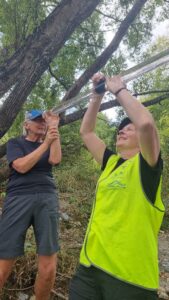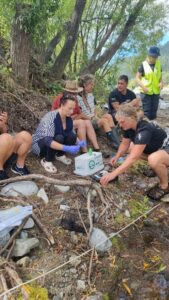Freshwater health monitoring training for Motueka catchment residents
On 16 and 17 February a committed group of Motueka catchment residents attended training at the Pokororo Hall and Pokororo Stream on how to use a SHMAK – Stream Health Monitoring and Assessment Kit.
This followed from a meeting run by the Freshwater Monitoring Thematic Group of the Motueka Catchment Collective in November, to talk about how the community could be involved in monitoring sub-catchment waterways, particularly those waterways not being monitored by Tasman District Council or Tasman Bay Guardians.
This initiative, and the goals of the Freshwater Monitoring Group, focus on the adage “you manage what you measure”. If you meaure stream health, you’re more likely to take action to improve it if that’s what’s needed… or equally celebrate, value and learn from if it’s great quality!

Left: Tasman Bay Guardians facilitator Kate Radloff with Cathie Johnson looking at a clarity tube and right TBG facilitator Monique Patterson demonstrating the phosphate test
The training included both theoretical learning and practical hands on demonstration and practice, and was delivered by experienced facilitators from the Tasman Bay Guardians. Monique Patterson from TBG said of the event:
We had a great group of motivated and interested participants over the two days, and we as a team thoroughly enjoyed sharing the SHMAK kits tools with everyone. It was an opportunity to demystify monitoring by breaking it down to its simple components. This makes it accessible and achievable for people to begin to understand changes in the health of their waterways. Particularly exciting was the emergence of small groups within sub-catchments showing interest in working together to monitor their streams.

Michael Malone, a resident of Pangatotara on the Westbank Road, attended the event because:
“I was interested in the SHMAK kit as my former work involved hydrology, river pollution monitoring, water testing and treatment. The kit appeared quite simple to use and ideal for basic stream monitoring.
Michael enjoyed the event saying:
It was great to get together with similar minded people who are enthusiastic about maintaining our river environment.”
The next steps of this project is to:
- Establish specific sites that will be monitored on regular basis
- Organise depots and lending/hire arrangements for SHMAK kits and their use within the Motueka Catchment;
- Support groups willing to be long term monitoring their sub-catchment on monthly basis
- Collect the data and discuss with experts if we might need extra monitoring efforts using more accurate techniques if needed.
The MCC will update the community about the progress of this exciting initiative.
The NIWA website talks about how a SHMAK kit works:
Stream health is the condition (or state) of the whole stream ecosystem, including water quality, physical features of the stream and its banks, and the plants and animals living there. It also includes aspects that affect human health, safety and enjoyment.
Monitoring means making a standard set of measurements and observations at regular intervals and keeping records of the results so that they can be compared over time.
SHMAK provides a way to assess whether land-use practices are affecting waters. It also allows stream health to be tracked over time, so you can recognise if stream health is getting better, worse or staying the same. The function of this kit is not to replace more formal methods of stream health monitoring. It is an additional tool to empower communities to play their own role.
If you’re interested to know more about the SHMAK kit and what is measured, take a look at this monitoring manual and the NIWA website.

